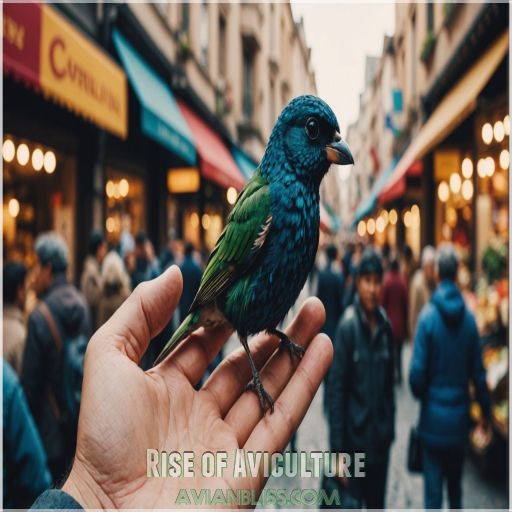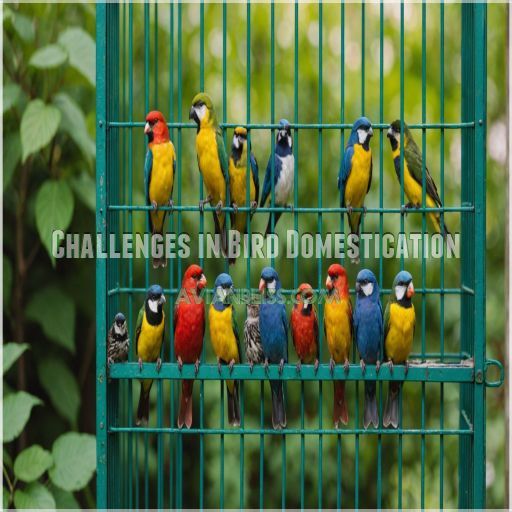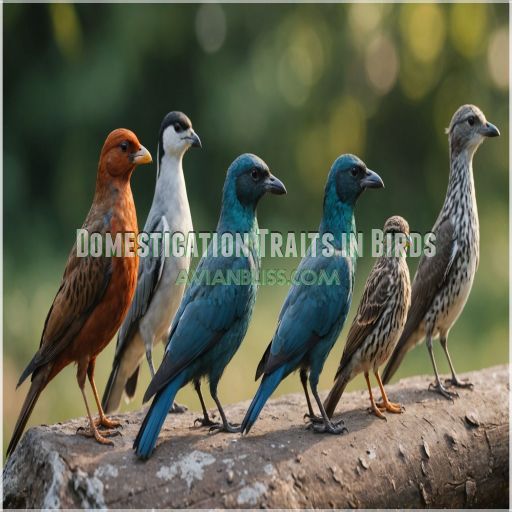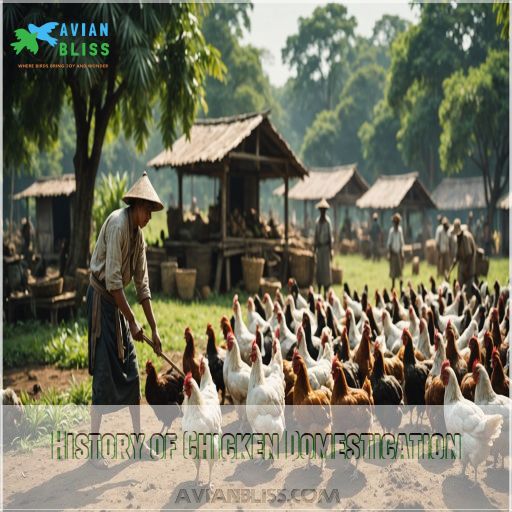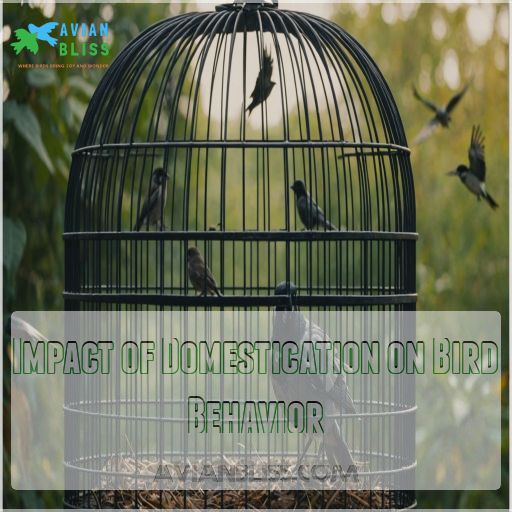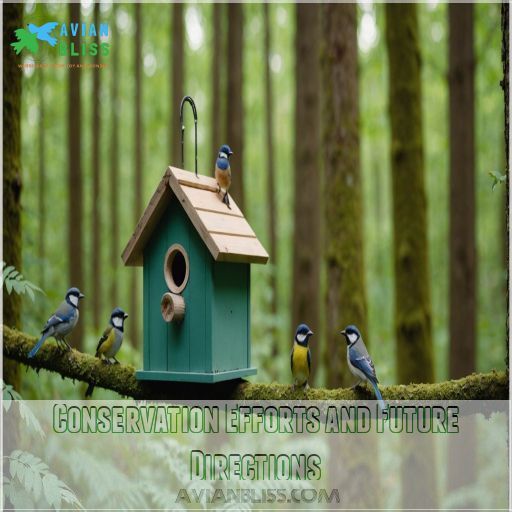This site is supported by our readers. We may earn a commission, at no cost to you, if you purchase through links.
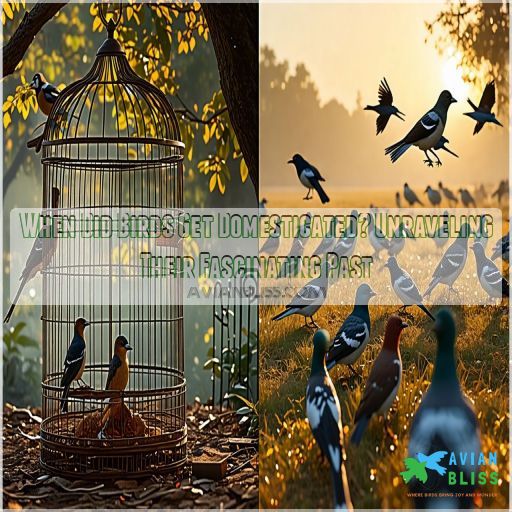
You might be surprised to learn that geese were likely the first to join our human flock around 7000 years ago in China. Chickens weren’t far behind, though their exact domestication timeline is still a bit of a feather-ruffling debate among researchers.
Our feathered friends have come a long way since then, evolving from food and feather sources to beloved pets and important farm animals. This transformation didn’t happen overnight – it’s been a gradual process of selective breeding and adaptation.
The story of how different bird species became part of our daily lives is more intriguing when learning about long-living bird species
.
Table Of Contents
- Key Takeaways
- Origins of Bird Domestication
- Domestication of Poultry
- Rise of Aviculture
- Challenges in Bird Domestication
- Domestication Traits in Birds
- History of Chicken Domestication
- Impact of Domestication on Bird Behavior
- Conservation Efforts and Future Directions
- Frequently Asked Questions (FAQs)
- When was the first bird to be domesticated?
- Are chickens the first bird species to be domesticated?
- How did bird domestication start?
- When did chickens become domesticated?
- When did humans first domesticate birds?
- When did people start keeping birds as pets?
- When did humans start using birds?
- When did birds stop being reptiles?
- How do pigeons differ from other domesticated birds?
- What role did rice cultivation play in chicken domestication?
- How have modern farming practices affected poultry breeding?
- Why were chickens initially domesticated for entertainment?
- How has avian influenza impacted poultry farming?
- Conclusion
Key Takeaways
- You might be surprised to learn that geese were among the early birds to be domesticated, joining our human flock around 7,000 years ago in China. Who knew these honking heroes would pave the way for our feathered friends?
- Chickens clucked their way into our lives about 5,000 years ago, but they weren’t initially raised for food. These plucky birds were first tamed for cockfighting entertainment, proving that even in ancient times, people loved a good show.
- As you munch on your morning eggs, remember that modern poultry farming has dramatically changed our feathered friends. Today’s chickens are like bodybuilders compared to their ancestors, growing faster and bigger—but this super-sized transformation comes with its own set of challenges.
- You’re part of an ongoing story that’s been unfolding for millennia. From ancient rice paddies to backyard coops, our relationship with domesticated birds continues to shape not just our dinner plates but our cultures and ecosystems too.
Origins of Bird Domestication
You mightn’t know it, but ancient humans had a real thing for birds, using them for food, feathers, and even fashion tips.
Watching birds migrate taught us about the seasons, while their spiritual roles inspired myths that kept early storytellers busy for hours, and learning from them helped in many ways, including fashion and even spiritual roles of herons in georgia’s wetlands herons in georgia
.
Early Human Interaction With Birds
Imagine ancient times when you interacted with birds, perhaps using them for tools or marveling at their mythology.
Early humans saw birds as symbols and navigators—critter compasses guiding journeys.
You hunted them as food and eventually began their domestication.
Soon, pigeons and chickens became essential companions, leading to new roles in agriculture and as beloved pets (Source).
Bird Migration and Seasonal Changes
As the seasons change, birds’ migration patterns shift too, with many practicing torpor for survival
. You might spot some species arriving earlier each spring, while others depart later in fall. This is likely due to climate change impacting food availability and breeding cycles.
For example, some birds now travel 17 days longer on their fall migration than 40 years ago. Fascinating stuff, isn’t it?
Let’s take a closer look at the details:
- Many birds adjust their migration timing to match changes in insect hatches and plant blooms.
- Some species like Purple Martins and Tree Swallows may struggle to find food if they can’t keep up with these shifts.
- It’s interesting to note that males and females of the same species can exhibit different migration patterns over time.
Spiritual and Mythological Roles of Birds
Bird migration amazed our ancestors, sparking tales of wonder.
Birds, from fiery phoenixes to wise crows, shaped beliefs across civilizations.
These avian wonders acted as symbols of power, wisdom, and transformation. Their spiritual roles were so profound that they influenced early domestication.
Who wouldn’t be captivated by a creature that bridges worlds with just a flap of its wings, embodying a transformation and bridges worlds?
Domestication of Poultry
You’ve probably enjoyed chicken nuggets, but have you ever wondered when poultry first joined our dinner tables?
Around 7,000 to 10,000 years ago, humans in Southeast Asia started taming red junglefowl, sparking a relationship that would lead to today’s global poultry industry.
Timeline of Poultry Domestication
You’re intrigued by the tale of poultry domestication, starting in Southeast Asia thousands of years ago. From there, chickens spread to places like Ancient and the Harappan Civilization.
Over time, people found new ways to raise them:
- Religious rituals
- Cockfighting entertainment
- Selective breeding
- Artificial incubation
Like a TV drama, chicken history is full of twists!
Red Junglefowl as the Primary Ancestor
You might find it intriguing that the Red Junglefowl is the primary ancestor of domestic chickens, dating back over 8,000 years. These wild birds, teeming with genetic diversity, moved from jungle dwellers to farm fixtures.
The Red Junglefowl’s ancestors, like theropod dinosaurs, were bipedal creatures that likely roamed the earth millions of years ago, sharing a common ancestry with the mighty T. rex a shared dinosaur ancestry.
This unique lineage showcases the remarkable transformation from wild birds to domesticated poultry.
| Aspect | Wild Junglefowl | Domestic Chicken |
|---|---|---|
| Habitat | Forests | Farms |
| Dietary Habits | Diverse | Specialized |
| Genetic Diversity | High | Managed |
Wild vs Domestic highlights the dramatic shift.
Selective Breeding for Desired Traits
Imagine walking into a farm buzzing with clucking hens.
Selective breeding there isn’t just a numbers game. It balances genetic diversity and breed development with ethical considerations and health implications.
Farmers tweak traits to meet consumer preferences, ensuring your omelet’s journey is thoughtful. It’s like being the maestro of a poultry orchestra—cue the egg-citing symphony! .
Rise of Aviculture
You mightn’t know it, but the song of a canary wasn’t just a pleasant tune; it marked the start of aviculture many centuries ago.
Today, it’s not all sunshine and feathers—aviculture plays a huge role in conservation, and modern practices raise important ethical questions about how we care for our feathery friends.
Canaries and Songbirds as Early Pets
Canaries and other songbirds have long captured our hearts as beloved pets. Their enchanting melodies have captivated humans for centuries, with the first recorded bird shows dating back to the 1600s in Europe.
However, you should be aware of the distinction between keeping domesticated birds like canaries as pets and keeping wild birds, which is regulated by laws such as the Migratory Bird Treaty Act. In fact, many bird species are protected, and their capture and keeping require special permits.
Today, over 200 bird shows are held annually in the US, showcasing our enduring fascination with these feathered companions.
Aviculture’s Role in Conservation
As songbirds entertained in homes, aviculture soared to new heights, stepping onto the conservation stage.
You might consider breeding programs a feather in humanity’s cap, aiding endangered species.
By promoting habitat restoration and supporting wild populations, aviculture makes sure that our feathered friends don’t just survive but thrive. Ethical practices and thoughtful preservation can make a real difference.
Modern Aviculture and Ethical Considerations
Modern aviculture faces ethical challenges balancing bird welfare and captive breeding.
You must consider genetic diversity and ethical trade practices to support conservation programs.
Treat birds like family, not fashion statements. Make sure they’re housed in suitable environments to enhance their well-being and well-being and support sustainable practices.
Remember, happy birds sing a better tune, keeping biodiversity not just alive, but thriving.
Challenges in Bird Domestication
When trying to domesticate birds, you might face tough challenges like preserving genetic diversity and ensuring their welfare, which isn’t exactly a walk in the park.
Imagine trying to keep a creature that’s naturally free-spirited content in a cage without overstepping ethical boundaries—it’s a balancing act that would test anyone’s patience.
Loss of Genetic Diversity
Imagine a world where a bird’s gene pool shrinks like a sweater in a hot wash. Bird domestication faces the challenge of genetic diversity loss due to inbreeding, breed purity emphasis, and genetic bottlenecks.
Consider these:
- Inbreeding: Reduces resilience.
- Breed Purity: Limits diversity.
- Conservation Breeding: Necessary to retain genes.
Balanced efforts help maintain diversity.
Welfare and Treatment of Domesticated Birds
Consider the welfare and treatment of domesticated birds—a pressing issue in aviculture. You must prioritize ethical cage design and address overcrowding issues to promote bird health. Incorporate enrichment programs to keep these intelligent creatures mentally stimulated.
Here’s a quick guide:
| Factor | Challenge | Solution |
|---|---|---|
| Cage Design | Restrictive spaces | Ethical designs |
| Breeding Practices | Poor selection | Responsible choices |
| Enrichment Programs | Lack of stimulation | Daily activities |
| Bird Health Concerns | Disease management | Regular vet visits |
| Overcrowding Issues | Stress and aggression | Proper spacing |
Understanding these facets, you’ll raise happy, healthy birds.
Impact of Domestication on Wild Populations
While ensuring domesticated birds live well, consider wild populations. Domestication often leads to genetic diversity loss, making them vulnerable.
Wild neighbors suffer from increased competition for resources, habitat fragmentation, and disease transmission risks.
Additionally, providing unhealthy food options, such as feeding bread to birds, can lead to malnutrition and Angel Wing syndrome in wild birds.
This invasion can spark chaos, emphasizing the delicate balance needed in our feathered connections.
Domestication Traits in Birds
Ever wondered what sets domesticated birds apart from their wild counterparts?
From flashy feathers to flightless bodies, the fascinating world of domestication traits in birds is sure to ruffle your feathers.
Learn more and discover how centuries of selective breeding have transformed these feathered friends into the unique creatures we know and love today.
Changes in Plumage Colors and Body Size
Having tackled challenges like genetic diversity loss, let’s look at how birds’ plumage colors and body sizes evolved, particularly in red headed birds
.
Selective breeding brings vibrant color mutations, fitting human preferences. This process, shaped by natural selection, crafts birds into stunning visuals, much like choosing outfits in a bird fashion show.
So next time you spot a duck, thank those genetic tweaks.
Reduced Fear of Humans and Flight Ability
Bird domestication often leads to reduced fear of humans, with evolution peppering flightless breeds into the mix. This reduction in fear can be attributed to the birds’ natural instinctual fear response being diminished through human size and movement, allowing them to become more comfortable around humans.
Additionally, past negative experiences and learning also play a significant role in shaping the birds’ fear response, which is altered through domestication.
Through selective breeding, humans have nurtured birds that find our presence less terrifying than a horror movie. Over time, evolutionary changes have further diminished flight ability, making some domesticated birds more like couch potatoes than their wild, evasive relatives.
Ain’t that something?
Adaptation to Captivity and Reproduction
Captive breeding programs aim to sustain populations, but challenges arise when birds are removed from their natural habitats. Birds may struggle to adapt to captivity, experiencing stress and reduced reproductive capacity.
This is influenced by factors like time of year and duration of captivity. Strategies like captivity breeding programs, artificial incubation, and nest box design can aid in overcoming these challenges.
Captive breeding programs intensively manage reproduction and demographics to maintain genetic diversity.
Artificial incubation techniques, like brooders, can help hatchlings survive. Nest box design also plays a role in reproductive success, with some species preferring enclosed boxes.
History of Chicken Domestication
You’re about to explore the journey of chickens from wild red junglefowl in Southeast Asia to the stars of your Sunday roast.
Buckle up as you discover how ancient Egyptians and Romans contributed to their rise.
How modern farming turned chickens into the global phenomenon they’re today.
Ancient Origins and Spread of Chickens
You’ve seen how domestication changed birds, but let’s scratch beneath the surface of chicken history. Believe it or not, these feathered friends didn’t always rule the roost. Their journey from jungle to backyard is a real page-turner!
- Chickens first pecked their way into human lives around 1650-1250 BCE in Thailand
- Rice fields acted like a bird magnet, drawing wild jungle fowl down from the trees
- These early birds weren’t instant dinner – they were exotic showstoppers for centuries
Egyptian and Roman Contributions to Chicken Domestication
Ancient civilizations transformed the humble chicken into a cultural icon.
Egypt’s incubation wizards cracked the code of artificial hatching, freeing hens to lay more eggs.
Meanwhile, Roman gourmands elevated chicken to delicacy status, inventing culinary marvels like stuffed birds and omelets.
Chicken fighting became a spectator sport, with Pergamum even building an amphitheater for feathered gladiators.
It’s a tale of innovation, taste, and a dash of cockfighting drama!
Modern Chicken Farming and Cultural Impact
Fast forward to today, and you’ll find chickens have gone from royal pets to dinner staples.
Factory farming has revolutionized production, but it’s not all sunshine and rainbows. Ethical concerns cluck loudly as birds are packed tighter than sardines.
Yet, chicken’s cultural significance keeps growing – it’s the chameleon of cuisines, adapting to global tastes faster than you can say "finger-lickin’ good". From tikka masala to General Tso’s, these birds are ruling the roost worldwide.
Impact of Domestication on Bird Behavior
You might think your pet bird’s quirky habits are just its personality, but domestication has actually rewired their behavior from the inside out.
From changes in social structure to altered breeding patterns, the impact of living alongside humans has shaped our feathered friends in ways you’d never expect, such as affecting their breeding patterns.
Changes in Social Structure and Communication
Domestication has ruffled the feathers of bird social structures. You’ll notice that domesticated birds, like chickens, have adapted to larger, more dynamic groups compared to their wild ancestors. This shift has sparked some fascinating changes in how they interact and communicate.
Let’s peck at a few key points:
- Flock dynamics now revolve around artificial hierarchies
- Communication signals have evolved for crowded environments
- Social behaviors show increased tolerance for close quarters
These changes are like a bird learning a new song – it takes time, but they’ve adapted beautifully to their new domestic tune.
Effects of Domestication on Mating and Breeding
You’ve seen how birds chat differently now, but let’s ruffle some feathers and talk about the love life of our feathered friends, who have a surprisingly long lifespan like the house sparrows that can live up to 12 years
.
Domestication’s got these birds singing a whole new tune regarding mating. Their breeding instincts have taken quite a turn, with some surprising genetic impacts.
For example, domesticated ducks are packing more heat than their wild cousins – if you catch my drift. It’s nature’s way of adapting to our human world, and these changes are having a significant impact on the birds’ behavior and physiology, particularly in terms of their breeding instincts.
Adaptation to Human-Provided Environments
The cozy nest of domestication has transformed our feathered friends.
You’ll notice bird behavior changes as they adapt to human-provided environments. They’ve learned to thrive on readily available food, often ditching their wild instincts.
Nest site adaptation is a real feather in their cap, with birds getting creative in urban settings.
Housing conditions play a big role too – it’s not just about having a roof over their beaks, especially when considering the cozy nest of domestication and how it impacts their behavior in urban settings.
Conservation Efforts and Future Directions
You’re about to discover how bird conservation efforts are shaping the future of both domesticated and wild species.
From sustainable aviculture practices to addressing threats like habitat loss, we’ll explore the cutting-edge strategies that are helping our feathered friends.
We’ll delve into the ways these strategies are helping our feathered friends thrive in a changing world.
Role of Aviculture in Conservation
Feathered friends in captivity play a key role in conservation efforts. You’ll find aviculture spreading its wings to protect endangered species through captive breeding programs for species like the cardinal which is not considered least concern birds
.
Let’s ruffle some feathers and explore how bird-keeping can make a difference:
- Promoting adaptive traits in captive populations
- Enhancing visitor engagement with conservation stories
- Integrating One Plan Approaches into collection planning
By bridging the gap between captivity and the wild, you’re helping to preserve genetic diversity and guarantee our feathered pals don’t fly off into extinction.
Threats to Domesticated and Wild Bird Populations
While aviculture plays a role in conservation, our feathered friends face a storm of threats.
Habitat loss is like bulldozing their homes, while climate change turns their world upside down.
Disease spreads like wildfire, and invasive species crash their parties.
Even our furry companions pose a risk – cats are bird-nappers extraordinaire, snatching up to 988 million birds annually in the U.S. alone.
It’s a tough world out there for our winged pals!
Sustainable and Ethical Bird-Keeping Practices
You’ve heard about the threats to our feathered friends, but let’s turn over a new leaf! Sustainable bird-keeping isn’t just for the birds—it’s a win-win for everyone.
- Support bird sanctuaries that prioritize conservation
- Choose ethically bred companions from reputable sources
- Enrich your bird’s habitat with toys and activities
- Provide proper nutrition and spacious housing for excellent welfare
Remember, happy birds make for happy homes!
Frequently Asked Questions (FAQs)
When was the first bird to be domesticated?
Birds of a feather flock together, but geese led the way.
Recent findings suggest geese were domesticated around 7000 years ago in China, potentially making them the first domesticated birds.
Chickens followed suit about 2000 years later.
Are chickens the first bird species to be domesticated?
Contrary to popular belief, chickens weren’t the first domesticated birds.
Recent evidence suggests geese took that title about 7,000 years ago in China.
Chickens followed later, with firm evidence dating back only 5,000 years (Source).
How did bird domestication start?
Around 10,000 years ago, our ancestors began taming wild fowl, like the red junglefowl, for food and cockfighting.
They selectively bred birds with desirable traits, gradually shaping them into the diverse chicken breeds we see today.
When did chickens become domesticated?
Picture ancient rice fields teeming with wild fowl.
You’d be witnessing the birth of chicken domestication, roughly 3,500 years ago in Southeast Asia.
These red jungle fowl gradually became our feathered friends, transforming from wild birds to barnyard staples.
When did humans first domesticate birds?
Humans have been domesticating birds for thousands of years.
Pigeons, chickens, and geese were domesticated early on, and turkeys were domesticated in Central America around 800 BCE.
Today, there are many types of domesticated birds, including ducks, quail, and ostriches, which are all a part of the broader category of domesticated birds.
When did people start keeping birds as pets?
Ever wondered when our feathered friends first became household companions?
You might be surprised to learn that Egyptians were keeping birds as pets as far back as 4000 BC, long before they became a common sight in our homes.
When did humans start using birds?
Birds have been used by humans for thousands of years, with some estimates placing the domestication of pigeons at 10,000 years ago.
They’ve been used for food, communication, and even beauty.
Today, pigeons are still used for racing and as pets.
When did birds stop being reptiles?
Like a family tree with hidden branches, birds never truly stopped being reptiles.
They evolved from dinosaurs about 150 million years ago, but scientifically, they’re still classified as reptiles due to their shared ancestry .
How do pigeons differ from other domesticated birds?
Pigeons stand out among domesticated birds with their remarkable homing ability and diverse breeds.
You’ll find them covering long distances, performing aerial acrobatics, and sporting a wide range of shapes and sizes.
They’re truly the chameleons of the avian world.
What role did rice cultivation play in chicken domestication?
Did you know chickens were domesticated around 3,500 years ago?
Rice cultivation played a pivotal role, acting as a magnet for wild jungle fowl.
As you planted paddies, these birds flocked to feast, kickstarting their journey to becoming your feathered friends and marking the beginning of their journey .
How have modern farming practices affected poultry breeding?
Modern farming has turbocharged poultry breeding.
You’ll find chickens grow faster and bigger, but at a cost.
They’re facing health issues and welfare concerns.
It’s a balancing act between efficiency and bird well-being in today’s poultry industry.
Why were chickens initially domesticated for entertainment?
You’d be surprised, but our feathered friends were first tamed for their fighting spirit.
Cockfighting was the initial draw, not food. Ancient folks found the birds’ battles thrilling, turning them into crowd-pleasing entertainment long before they became dinner.
This was the main reason for domesticating the birds, as is often overlooked in history. Ancient folks found the birds’ battles thrilling,
How has avian influenza impacted poultry farming?
Who knew a tiny virus could ruffle so many feathers?
Avian flu’s hit poultry farming like a fox in the henhouse. It’s devastating flocks, causing 50% mortality rates, job losses, and trade restrictions.
Even wild birds aren’t flying free from its impact, causing widespread 50% mortality rates (Source).
Conclusion
From ancient China to modern farms, the journey of bird domestication has been a wild flight through time.
As we’ve unraveled when birds got domesticated, we’ve seen how these feathered companions have transformed our lives and cultures.
Whether you’re enjoying eggs for breakfast or watching your pet parrot mimic your words, remember – you’re part of a millennia-old relationship.
The story of domesticated birds isn’t just history; it’s an ongoing tale of human-animal bonds, shaping our shared future one chirp at a time.



